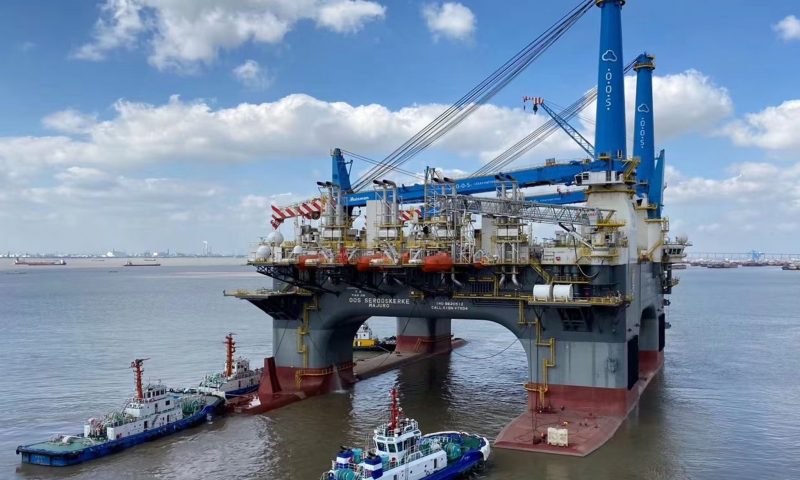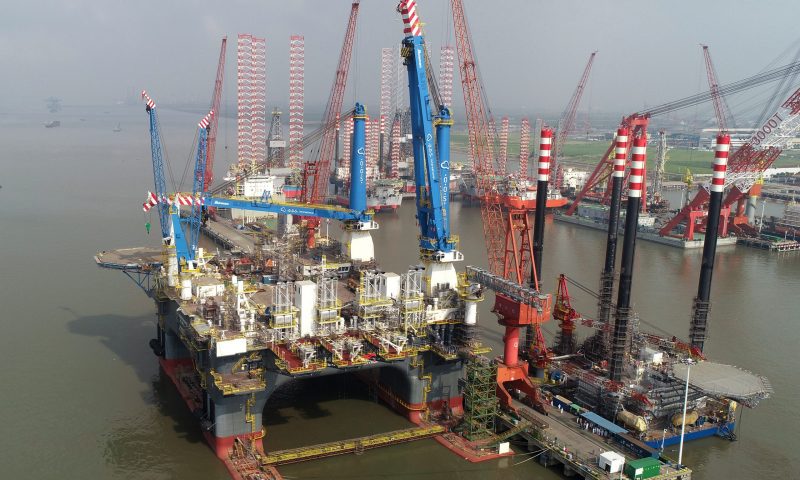
SSCV OOS Serooskerke Sea Trial
The world’s most advanced semi-submersible heavy lifting platform will be towed out of the river from Nantong.
The width of the towing and the difficulty of the operation set a new record in the history of navigation on the Yangtze River. The entire Jiangsu section of the Yangtze River will implement downstream ship traffic control.
Under the strict maintenance of the Nantong Maritime Safety Administration’s sea cruiser and 6 high-horsepower tugboats, the world’s most advanced semi-submersible heavy crane life platform “OOS Serooskerke” slowly left China Merchants Heavy Industries (Jiangsu) Co., Ltd. outfitted the dock, completed the formation and started the towing journey out of the river. It is reported that the total length of the platform is 137.75 meters, the molded width is 81.0 meters, the molded depth is 12.0 meters, and the maximum height above the water is 96.3 meters. The total length of the towing vessel formation is 399 meters and the width is 101 meters.
The “OOS Serooskerke” platform is manufactured by China Merchants Heavy Industries (Jiangsu) Co., Ltd. It adopts a left-right asymmetrical pontoon and column design. It is equipped with 6 single 3800KW propellers. The combined hoisting capacity of the crane is 4400 tons, which can be 750 at the same time. People provide comfortable and safe living and working conditions. The variable load of storm self-existing conditions can reach 6,300 tons, and it can work under severe conditions. It is equipped with DP3 closed-loop dynamic positioning system. It has oil and gas production, installation modules, underwater services, and dismantling. Platform, service support and other functions. Compared with the previous world’s largest semi-submersible heavy-lifting life platform “Pioneer Spirit”, this platform has the same functions but more advanced technology and information technology and more competitive construction costs.
The total length of the ship formation for this towing operation is 399 meters, the width is 101 meters, and the draft is 10.5 meters. The width of the towing and the difficulty of the operation both refresh the previous records of the navigation history of the Yangtze River. Therefore, the operation activities require extremely objective conditions such as hydrology, meteorology, and navigation environment. high. The average daily flow of ships in the waters of the ship formation is more than 2500. The flow of ships is large and the navigation environment is complicated. The towing formation exists during the period of departure, formation, crossing anchorage, crossing the main channel, port navigation, docking and mooring.
In order to ensure the safety of towing on the “OOS Serooskerke” platform, under the unified coordination and command of Jiangsu Maritime Safety Administration, Nantong Maritime Safety Administration meticulously formulated a traffic organization and maintenance plan, issued large-scale towing permits, issued navigation notices, and organized relevant port and shipping companies to adjust The voyage production plan, as far as possible, “gave way” for the platform towing out of the river. During the platform unberthing and towing period, the maritime departments of Nantong, Changshu, and Taicang strengthened the overall linkage, implemented temporary traffic control on the navigable waters in advance, and dispatched 7 marine patrol boats to escort the whole process. The maritime departments of the entire Jiangsu section of the Yangtze River will organize the implementation of downstream ship traffic control, stagger the towing nodes of the fleet in advance, and ensure the safety of navigation during the towing period of the “OOS Serooskerke” platform.
The “OOS Serooskerke” platform will temporarily dock at the Taicang Port Container Terminal at 1600 o’clock on October 9th , and leave the Jiangsu section of the Yangtze River in the early morning of the 10th, heading for the Shanghai Lvhuashan anchorage.












